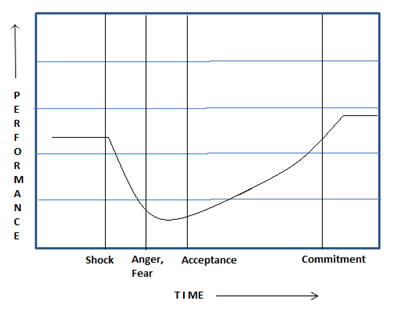In modern world when change is the only constant thing, businesses and organizations should keep adapting to the fast paced market changes. Nowadays, rapid changes are happening in technology, management and other fields every day. So, preparing the organization for change and executing the change without impacting employee morale is a very crucial and important task for an Organization and its leaders.
Some of the scenarios where organizations undergo change are:
- Need to adapt to Change in market demand and competition
- Growth and advancement in technology
- Changes in management, Vision & Mission
- Mergers & Acquisitions
- Business & Product Expansion or modification
- Business Process Reengineering
‘Need for change’ can arise due to factors internally or externally. But organizations will have to manage change willingly or otherwise. Therefore it is wise that leaders pay enough attention to understand the impact that Change brings to its employees and operations, and work towards resolving their problems without impacting the transition.
One of the major obstacles that affect the transition process is ‘Employee Resistance to Change’. Management experts say that employees undergo the following stages while a change is being implemented in an organization. The below graph explains the stages experienced by employees during a Change Implementation process.
The duration of the curve will be longer with improper management of Change Execution. On worst cases management may have to revert back to the old process/policy before change.
The efficiency of the management lies in identifying the real concerns of employees and resolving them, which will steer the change implementation process. For this, Top management executives should be knowledgeable in the Change Management Methodology.
Change Management is the approach/task of smoothly transitioning the organization and its employees to a desired future state. As discussed earlier, Change management is needed in various scenarios by the management. It focuses on understanding the human component & feelings involved in accepting and cooperating to change process and in adapting to the new state.
Executives responsible for Change should understand that forcing change will not only be useful but will result in negative effects.
Typically, the steps involve in Change management can be described as below.
- Identify and formulate the desired state of the process & Change management plan
- Identify the desired state & change
- Formulate the Changes to be made in processes, policies, organization structure and other areas.
- Develop a change management plan and duration
- Communicate the change process and collect Employee concerns
- Formulate a communication plan with duration.
- Communicate to all levels of management with the required details
- Make them understand the need for change and the benefits of change to self and the organization
- Collect employee concerns and address them with proper care and attention
- Implement the changes proposed
- Stick to the plan and implement tasks one by one
- Make mid-level corrections based on learning and feedback
- Reward the efforts of team and individuals
Though it is a three step process, Steps 1 and 2 are very important.
Without detailed and proper planning, employees will not get convinced that the new policy/process will benefit them. It is a disaster to go ahead with Change management without proper planning.
Communication of change items and process to the employees is another important task. Executives should realize what information should be shared to which level of people. Also, it is important to be honest and transparent. ‘Being Transparent’ and ‘Sharing Relevant Information’ are two items that might sound contradictory, but intelligent Executives will be able to do both of these simultaneously.
Thus Planning and Communication completes more than 75% of the change management process. The remaining work can be taken care with motivated employees and by delegating the tasks to right skilled people.

